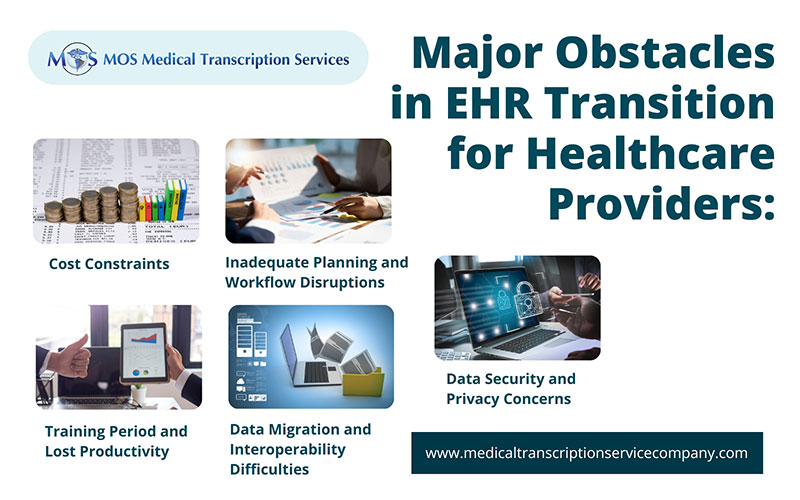
Table of Contents
The digital boom has fundamentally transformed the healthcare industry, revolutionizing everything from daily operations to medical transcription, billing and patient experiences. However, this technological shift comes with its own challenges. Healthcare practices continue to grapple with a range of common and specialty-specific issues, one of the most prominent being the implementation of Electronic Health Record (EHR) systems. Medical transcription services play a key role in the transition to digital patient records. However, while EHRs promise improved efficiency, accuracy, and patient care, their adoption often presents significant obstacles-ranging from technical complexities to resistance from staff and providers. These growing issues highlight the need for thoughtful integration and ongoing support to fully realize the potential of digital health technologies.
A Becker’s Hospital Review article cited KLAS Research, which identified EHR implementations as one of the weakest aspects of the user experience, with customer satisfaction declining since 2022. According to the research report published on January 10 this year, approximately 40% of healthcare leaders faced significant challenges with recent EHR implementations, while only 38% deemed their efforts successful.
What is EHR Implementation and why is it Important?
EHR implementation refers to the strategic process of selecting, introducing, and integrating an electronic health record system into a healthcare provider’s settings. It requires careful planning, preparation, and execution of the EHR software, as over 40% healthcare leaders report significant implementation challenges.
The key steps involved in the EHR implementation process are as follows:
- Planning and assessment
- System design and customization
- Data migration and testing
- Go-live and post-live support
- Staff training and ongoing optimization
The importance of EHR implementation lies in its ability to streamline patient care, reduce medical errors, and enhance overall healthcare delivery. By digitizing patient records and outsourcing medical transcription, healthcare providers can quickly document, access and share critical information, improving coordination among care teams and enhancing patient outcomes. Additionally, EHR systems help healthcare organizations meet regulatory requirements, improve efficiency, and reduce administrative costs, ultimately contributing to better patient care and organizational performance.
Key Challenges in EHR Implementation
- 1. Cost Constraints
Implementing health information technologies such as EHR, PMS, and patient portals can be a significant financial burden for many healthcare practices, particularly during the initial stages. A successful EHR system requires not only substantial investments in software and hardware upgrades, but also in technical infrastructure to ensure smooth operation. Additionally, there are secondary costs such as staff training, ongoing subscription fees, and system maintenance, all of which add to the overall financial load. For smaller and independent practices, the challenge of securing the necessary funding to cover the total cost of ownership can be an overwhelming obstacle to successful EHR adoption.
- 2. Inadequate Planning and Workflow Disruptions
One of the biggest concerns in EHR implementation is the lack of comprehensive planning and effective change management during the integration process. When healthcare leaders, stakeholders, and EHR vendors fail to communicate clearly and misalign their expectations, it can lead to poor outcomes and unmet goals. A survey by KLAS Research revealed that insufficient change management and adoption strategy was ranked as the top challenge by healthcare organizations. Without a thorough strategic assessment and detailed planning to address the specific objectives of the EHR system, the deployment process can lead to serious consequences, including existing workflow disruptions, escalating costs, missed timelines, and understaffing.
- 3. Training Period and Lost Productivity
Limited and weak staff training programs can disrupt the effectiveness of implementing an EHR system. Organizations may skimp on providing adequate training periods and resources due to the additional time, effort, and cost required. However, poor training sessions can result in staff resistance, reduced productivity, and improper use of the EHR system. This can lead to errors in patient data entry, longer patient wait times, and a decline in overall service quality. Moreover, the learning curve associated with new systems can temporarily decrease staff efficiency, further compounding productivity loss during the transition period.
- 4. Data Migration and Interoperability Difficulties
One of the major hurdles during the transition from paper-based records to an electronic-based record system is the transfer of patient medical information. Inaccurate or incomplete data migration can lead to significant clinical errors, data loss, interoperability challenges, and delays in patient care, undermining the overall efficiency of healthcare practices. This poses significant barriers to seamless coordination of care, continuity of services, and ultimately, patient health outcomes. Incompatible systems may prevent critical information from being shared across departments, facilities, or even between different healthcare organizations, leading to fragmented care. As a result, patients may face duplicated tests, delayed diagnoses, or missed treatments.
- 5. Data Security and Privacy Concerns
EHRs store highly sensitive and confidential patient information, making them prime targets for cyber threats, especially during the transition from paper-based systems. Not all EHR software is equally secure, making patient data more susceptible to breaches and cyber threats. Without robust cybersecurity measures in place, health data is at risk of consequences such as ransomware attacks, unauthorized access, or data loss. Healthcare organizations must ensure that adequate encryption, secure access controls, and comprehensive data protection protocols are implemented to safeguard patient privacy and meet regulatory requirements, such as HIPAA. Failure to do so could result in severe reputational damage, legal consequences, and a loss of patient trust.

Effective Strategies to Overcome EHR Implementation Challenges
Even though EHR implementation is a challenging, taxing, and complex process, with an effective and well-structured strategy, healthcare organizations can streamline the transition process. Here are the key steps to follow for a seamless EHR integration process:
- Plan Thoroughly
Before initiating the EHR implementation process, assess your current workflows and systems. Set predefined objectives that relate closely to the organization’s goals and objectives so that everyone knows the purpose behind having the new system. A detailed timeline and roadmap will guide the entire process, helping to avoid common pitfalls and ensuring smooth integration.
- Get Key Stakeholders Involved
Engaging physicians, nurses, and IT professionals from the outset is crucial to the system’s success. The input they provide ensures that the newly installed EHR system will work for those who will use it most, the clinic staff. A dedicated project team for the implementation process will keep everything organized and focused throughout the transition.
- Provide Adequate Training and Support
Hands-on training sessions for all users are necessary to get them familiar with the new system. There is a need for ongoing support post-implementation, as issues or questions are bound to arise. User-friendly manuals and resources should be made available to help users navigate the system independently when needed.
- Choose the Right EHR Vendor
While there is more to the success of an implementation than the selection of the right EHR vendor, getting this choice right can make all the difference. Research in advance to find a vendor whose system fits your particular needs for your practice. Look for services with a history of successful implementations and whose system is adaptable enough to evolve as the needs of your practice change.
- Test the System before Full Implementation
Testing the system through a pilot phase will allow you to identify and fix issues before the full rollout. During this phase, select a group of users to test the system and in return, provide necessary feedback. Any glitches or inefficiencies discovered must be rectified before the system goes live to ensure a smooth transition for all users.
- Continuous Monitoring and Improvement
The performance of the system must be monitored regularly to ensure that the system is functioning as designed. Collect feedback from users regularly to make ongoing improvements. Keep the system updated with new features or enhancements to stay relevant and effective over time. By following these strategies, healthcare organizations can significantly reduce the challenges associated with EHR implementation, leading to a smoother transition and a more efficient digital health record system.
Overcome EHR Documentation Challenges with Medical Transcription Outsourcing
EHR deployment, while essential for modernizing health systems, is not without its challenges. One major issue is ensuring timely and accurate documentation. Before the widespread adoption of EHR systems, healthcare providers relied heavily on medical transcription services to document patient encounters. Today, EHRs have integrated many of these functions. However, transcription services remain vital for healthcare organization workflows. Due to the time-consuming nature of manual data entry, many organizations partner with a medical transcription company to reduce the administrative burden on clinicians. Experienced transcriptionists can ensure that detailed clinical notes are accurately captured and integrated into the patient’s digital record, promoting the prompt delivery of quality care.


